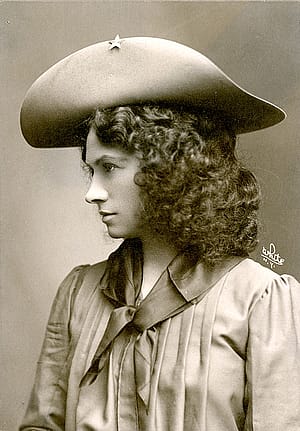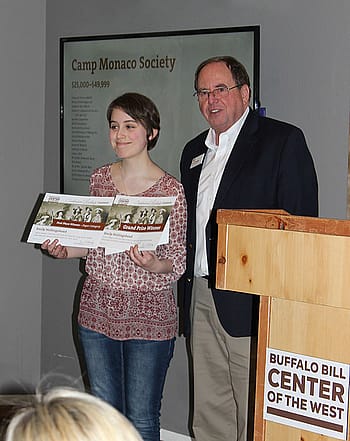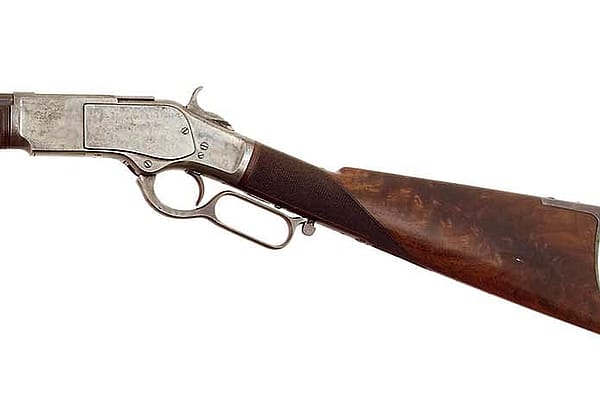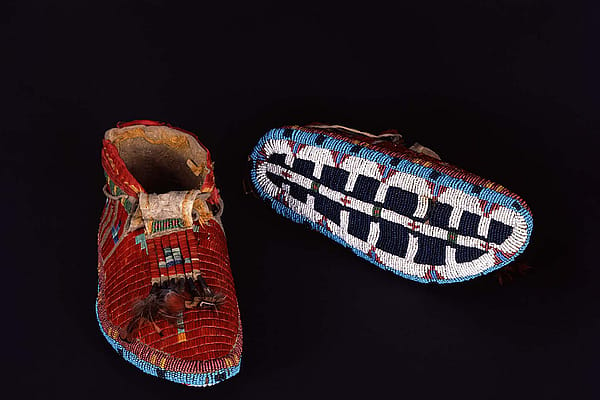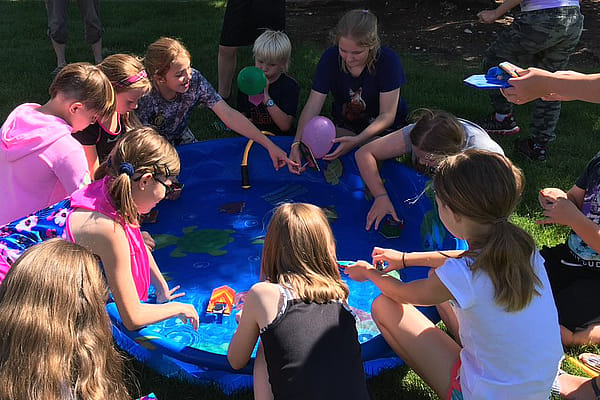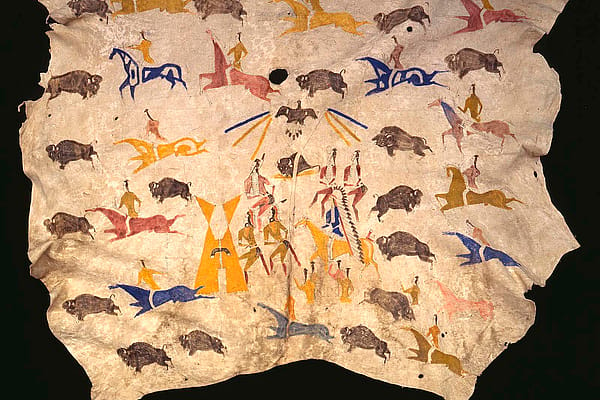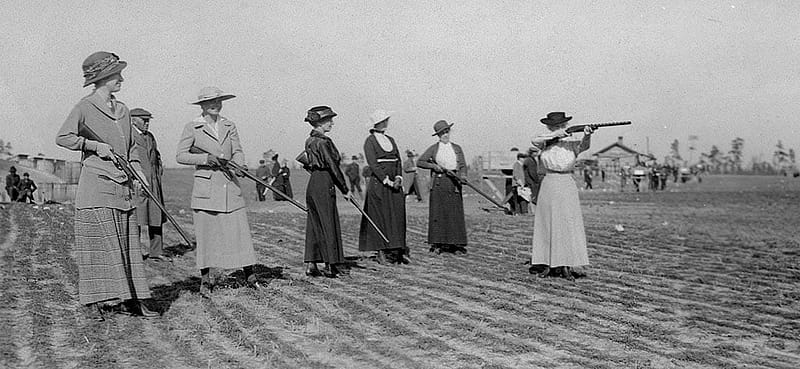
Grand Prize Winner: Emily Hollingshead with “Annie Oakley” essay
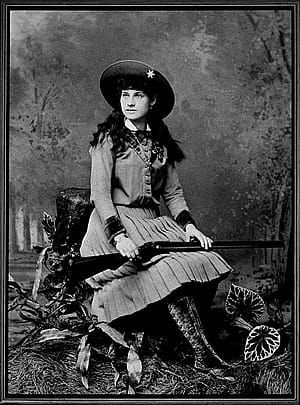
Thank you to all of the winners of our Centennial History Contest! The first place winner in the Paper Category is also our Grand Prize Winner: Emily Hollingshead from Cody High School. Here we post, in its entirety, Emily’s essay on Annie Oakley:
Annie Oakley: Little Sure Shot Aims for Equality—How Annie Oakley Advocated for Women’s Rights with Her Own Twist
By Emily Hollingshead
Senior Division / Historical Paper
Sometimes called the “Princess of the West,” Annie Oakley is largely considered one of the greatest American sharpshooters in history. She had a tremendous impact in her world by defying gender roles and making a bold statement about the realm of women during her life. She lived by example, leaving her audience thrilled and puzzled because she was “ladylike” while still excelling in a man’s sport. “You are a very clever little girl,” Queen Victoria of England told her, and her entire life proved the truth of that statement (Sorg). Annie Oakley took a stand for women’s rights by being the balanced middle ground, which was positively impactful for both sides of the feminism spectrum. Oakley never considered herself a feminist probably because society’s perspective of feminism was negative, and she cared immensely about how the public perceived her. Even so, she was anything but idle during this precarious time for women, using her respect among fans to her advantage. She steered clear of the political aspect such as women’s suffrage, and instead aimed for issues that could expand a woman’s world and lifestyle.
Oakley learned to shoot a gun at a young age, and used this skill to hunt and to compete in contests for money. Her natural talent astonished those in her little town, and she was invited to a shooting competition in which she would win against her future husband, Frank Butler. They travelled the United States performing as “champion rifle shots,” even joining a circus for a season, until Colonel Buffalo Bill Cody saw their performance. In 1885, they joined Buffalo Bill’s Wild West show. While before, Butler and Oakley were a duo, now Oakley was performing on her own and Butler was her manager and assistant. They stayed with the show for 16 years, travelling across the United States and Europe, performing for royalty and celebrities, and building a sizeable collection of medals and trophies (“Annie Oakley Biography”).
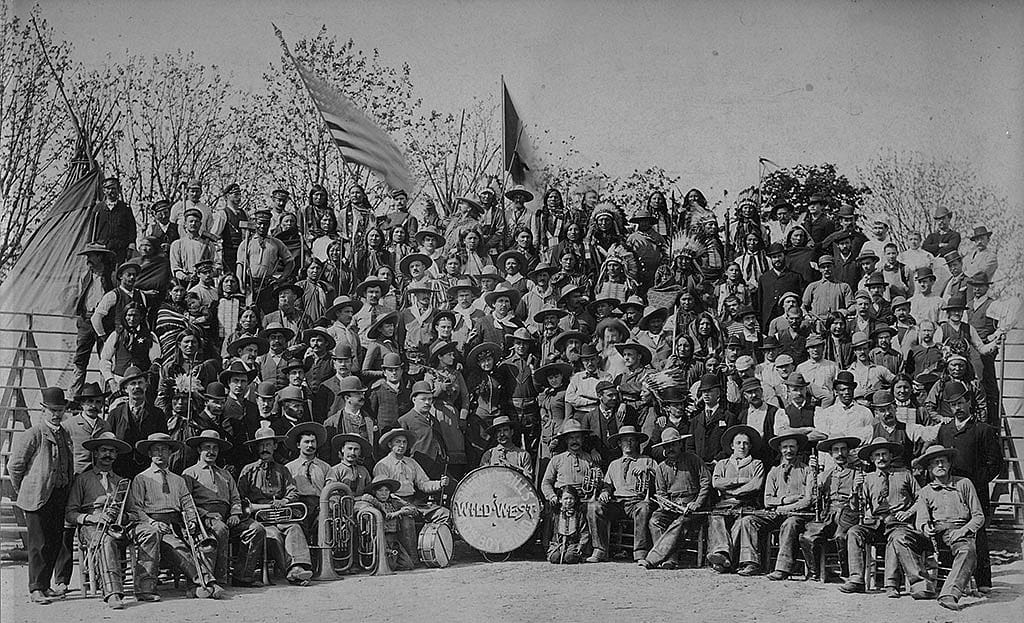
But what was it that made Annie Oakley so popular? There were certainly other incredible sharpshooters during her time. In an interview with the Smithsonian magazine, historian Joy Kasson explains: “I think the idea of a woman shooter, before Annie Oakley, might have seemed to be more along the lines of a freak show. As Dr. Johnson famously said about the dog that walks on its hind legs—it’s not whether it does it well—it’s that it does it at all” (“In a Man’s World”). Annie Oakley certainly did it well; she was incredible with a gun, but it wasn’t necessarily her skills that brought her fame. In order to understand how Oakley really impacted people, it is essential to see what she was dealing with exactly.
Born in 1860 and dying in 1926, Annie Oakley lived through three wars and great social changes within the United States. Women in that time, the Victorian Era, lived in a world of firm boundaries and expectations sometimes known as “the cult of true womanhood,” which is connected to the ideology that men and women dwell within distinctly separate “spheres” within society (Kerber). Men, people at that time believed, were more fit for the workplace and the public eye, while women thrived in domestic settings. Alexis de Tocqueville’s Democracy in America, published in 1835, explains the restrictions put on women: “the inexorable opinion of the public carefully circumscribes [her] within the narrow circle of domestic interests and duties and forbids her to step beyond it” (Tocqueville). Women were expected to be strictly homemakers with domestic jobs. Most women who worked outside the home were either nurses, teachers, or factory workers. Their wages were significantly less than men no matter their skill level. They were expected to stay at home and to always be calm and quiet. Sewing, reading, cooking, gardening, these were the “acceptable” activities laid out for women. “Strictly speaking,” Aileen S. Kraditor, a historian in the 1960s wrote in Up from the Pedestal, “Men have never had a ‘proper sphere,’ since their sphere has been the world and all its activities” (Kraditor). Women were significantly restricted in what they were allowed to do, how they were allowed to act, and who they were allowed to associate with. Women stayed with women and men associated with men, and there were strict rules and matters of etiquette to obey if one wanted to be accepted in society.
These are the kinds of issues Annie Oakley was up against. She walked a thin line between the two spheres, challenging society while appealing simultaneously to both sides of the spectrum. “It was uphill work,” She once said, “For when I began there was a prejudice to live down. It was not considered proper for a lady to compete in a man’s sport” (Fees). How she managed this balance can be found in the keyword: “lady.” She maintained the personality this society felt a woman should have. She was graceful, modest, sweet, clever, and acted as a civilizing force to the men she was always around while in her travelling show. This was quite effective, and it gave her a respected voice within both “spheres” of society.
Annie Oakley pushed the boundaries by proving that “a woman could be skilled with a gun and a horse and still be feminine” (Flynn). Oakley consistently dealt with assumptions and stereotypes. People flocked to her shows expecting to see a loud, large, masculine-like woman. Instead, they found a petite and polite lady who flourished at the supposed man’s sport of recreational shooting. Her family, specifically her mother, didn’t approve of her being in a show because of the negative stereotypes associated with showpeople and their morals. In fact, her mother believed show business to be a sin, according to Annie Oakley’s niece (Swartwout). So in her shows, she was not only smashing stereotypes regarding her gender, but of people in the show business in general, proving they could be just as civilized and gentle as anyone else in any other profession. She was considered a juxtaposition, a baffling paradox. This was revolutionary not just to those in the United States, but all across Europe too.
Oakley lived by example. “She had to make a girl that could shoot acceptable to a Victorian public,” says Virginia Scharff, a history professor at the University of New Mexico, “She’s inventing this new identity of the spunky Western girl who’s no threat to men who are good men” (Righthand). She made sure never to present herself as violent or dangerous, and was always quite aware of her own public image. Glenda Riley, author of Life and Legacy of Annie Oakley, describes her ladylike composure coupled with her progressive stance in society as “a subtle subversion” (Riley). This is because she was able to relate to both genders, and appealed to everyone no matter their stance on gender roles. She had a unique impact because she lived in a male-dominated society, yet acted completely ladylike, proving she could do “manly” activities without losing her femininity.
While many people would have disregarded her argument, her position and attitude made her a compelling figure to listen to. Even so, adversaries made it clear they didn’t appreciate her voice. A defining moment for Annie Oakley was when she took a stand for her own public image, which was as a role model for other women. In her early 40s and looking forward to a more peaceful life, having just retired from Buffalo Bill’s Wild West show, Annie Oakley was in for a shock. The reputation she worked so carefully to mold was quickly and mercilessly damaged because of a headline on a Chicago newspaper in 1903: “Famous Woman Crack Shot…Steals to Secure Cocaine” (Riley). The story quickly galloped into an outlandish tall tale: “Annie Oakley…lies today in a cell at the Harrison Street Police Station under a…sentence for stealing the trousers of a negro in order to get money with which to buy cocaine.” Over 55 newspapers around the country echoed this story. The country was shocked. According to another newspaper article looking back on it, published in 1931, artists drew before and after pictures, the latter drawings depicting Oakley as “seared, weazened, and haggard” (Riley); As a role model, as someone who had spent the majority of her life carefully crafting her public image in order to change society for the better, William Hearst’s Chicago newspapers threatened it all. The truth of the story was that a sleazy stage performer going by the name “Any Oakley” was the actual culprit of this story (Righthand).
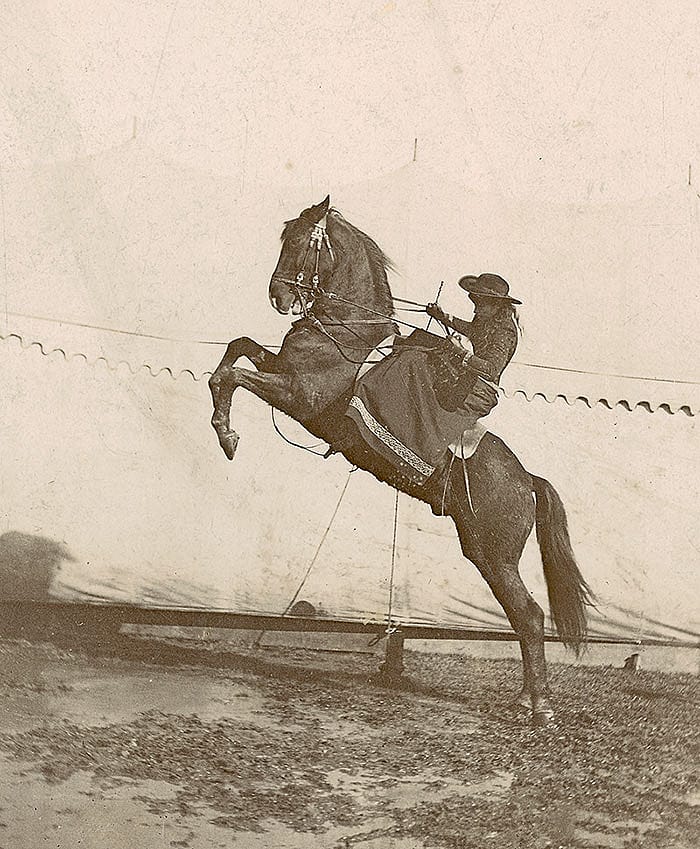
Though the majority of the newspapers apologized for the mistake and promised to retract their statements, Oakley knew it would have to take more than that to repair her reputation. So, for the next seven years, she would file 55 libel suits and won 54 of them (“Annie Oakley’s Libel Suits”). She was in and out of courtrooms constantly, but she maintained her ladylike, proper image the whole way through, aware of the public’s eye on her. She was determined to keep her good reputation because it offered hope to many women—the hope of a wider “sphere,” the hope of a balance between the two extremes of the “cult of true womanhood” and the noisy women’s suffrage protesters. During her trials, the opposing attorneys were rather offensive toward her, questioning her lack of education and her motives. Looking to further damage her reputation, William Hearst hired a detective to go scope out her hometown to find something to use against her. The detective couldn’t find anything negative (Riley). It is strange how adamant these people were about harming her reputation; it stems from a discomfort of newness; she stood for something new in a tumultuous era. She promoted an idea many people didn’t believe was proper, even though she took great care to show that it could be. She also did not put up with any unfairness in court. According to American Experience, “She once turned and left a South Carolina courtroom, telling opposing attorneys that this would give ‘you gentlemen who are such gallant defenders of women’s honor a chance to further your cowardice by shooting me in the back'” (“Annie Oakley’s Libel Suits”). By putting so much effort into standing her ground, by being firm and refusing to let the men she was surrounded by dictate her own identity and legacy, she was able to continue as a role model for women.
Annie Oakley wanted to broaden the horizons for women. She advocated for economic equality and worked fiercely to prove women could participate in the men’s “sphere” no matter how feminine they were. She declared that women should learn how to handle a gun and participate in sports. In her essay titled by “Why Women Should Shoot,” Oakley reasons:
Until recent years, woman has been debarred to a great extent from participating in many sports, pastimes, and recreations which in times past were looked upon as fit only for the opposite sex…When learning the use of firearms, a woman learns at the same time confidence and self-possession…. And are not these qualities of use also in daily life, and, therefore, all the more worthy of cultivation? (Oakley).

Furthermore, she actively worked to change society. Oakley taught at least 10,000 women how to shoot and hunt through the years, providing various lessons even after her retirement (Kasper). In both the Spanish-American War and World War I, she offered to train a group of sharpshooting women to help with war efforts. Both offers were ignored, but she was determined to do her part to help. Just like always, she refused to stand down, determined to show how useful women could be. She toured army camps across the country during World War I and raised money for the Red Cross by performing shooting demonstrations and even giving the men tips (Righthand).
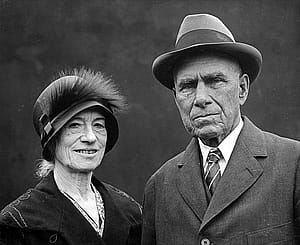
Even Butler and Oakley’s marriage was a progressive one. It was based on mutual partnership. Their relationship emphasized equality and versatile roles, a fluid and dynamic team instead of people of two “spheres” living together. Oakley was the one bringing in the income, performing, and dealing with the public while her husband stepped into the background to be her manager. Annie continuously clarified she did not believe the recreational activities she advocates for (such as hunting, cycling, etc.) should replace homemaking activities (Jean). She did not want to demolish the woman’s sphere, only broaden it. It is interesting to note that “she actually made more money than her fellow male performers, which undoubtedly strikes a blow to the modern purveyors of the gender ‘wage gap'” (Stepman).
Mary Zeiss Stange, a professor of Women’s Studies, perfectly describes why Oakley was so effective in her approach: “Annie Oakley is one of the first images available to the American populace-at-large of what a powerful woman could look like, especially to the extent that guns were associated with power…. Guns have always symbolized being powerful and knowing how to use power. In that regard, she’s a very significant figure and a trailblazer” (“In a Man’s World”). Annie Oakley paved the way for women to enjoy more economic rights and recreational variety. In Flynn Jean’s biography of Oakley’s life, she found a direct reference to Annie Oakley and the amount of female recreational shooters. In a 1920’s report in a sports magazine, the title announced: “Annie Oakleys Increasing—Females are Now Quite Generally Toting ‘Shootin’ Irons’ Along With Their Precious Powder Puff and Lipstick” (Jean). Oakley emphasized there was no need to abandon womanhood in order to enjoy sports and the outdoors. During Oakley’s lifetime, there was a leap in the number of employed women as well. In 1890, 4 million women (one out of seven) worked in jobs away from that women’s sphere, away from the domestic setting. In 1900, a million more were added to those ranks (one out of five) (Jean). It became more common to see women enjoying the outdoors and sports. Oakley had to take a stand, had to make the public comfortable with that image, and then thousands upon thousands of women eagerly followed.
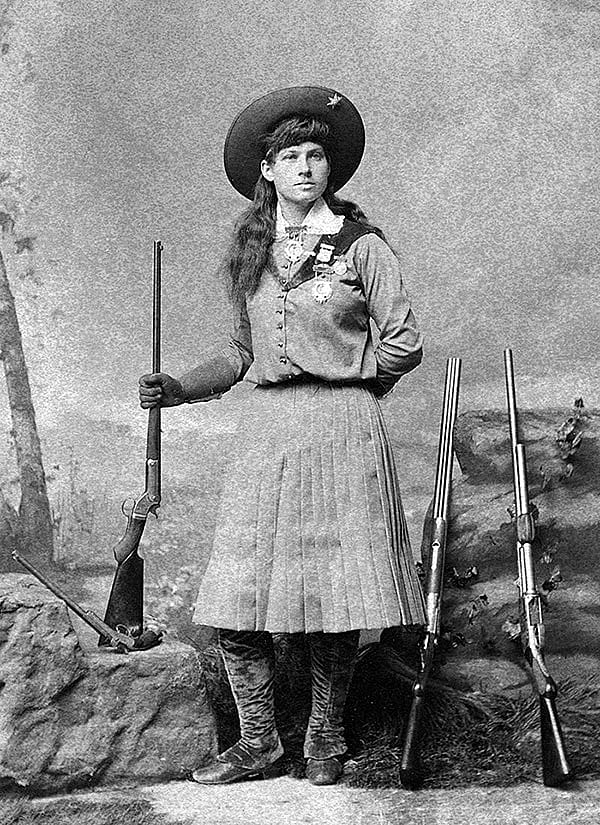
Annie Oakley continued to be a role model for women all of her life, and even through into the modern era. She lived in a world of firm boundaries and straight lines, but was able to take a stand for what she felt was a woman’s right to enjoy the various aspects of the world as much as any man. Because of her painstaking efforts to preserve her reputation, she can still be a role model for women and girls today. She did not want to change what it meant to be a woman, she wanted to enhance what it meant to be a woman.
Annotated Bibliography
Primary Sources
Annie Oakley. Cam. William Heise. Perf. Annie Oakley. Edison Manufacturing Co, 1894. Library of Congress. Web. 14 Mar. 2017.
This is a rare video of Annie Oakley performing, which I found during my researching process and found fascinating. It shows her in action, which helped me put her in perspective—it helped bring her to life for me.
Cooper, Courtney Ryley. Annie Oakley: Woman of Arms. New York: Duffield & Co., 1927.
This book is a biography written by a good friend of Annie Oakley’s who knew her personally and was inspired to write about her life. It expounds upon the fact that Oakley’s success came from her character more than her skill, a theme I also emphasized.
“Letter to President William McKinley from Annie Oakley.” National Archives and Records Administration. National Archives and Records Administration, n.d. Web. 21 Feb. 2017.
This is a scanned copy of the letter Annie Oakley wrote to President McKinley in which she offers to train female sharpshooters for the Spanish-American War.
Oakley, Annie. “Why Women Should Shoot.” Editorial. New York Sun 3 June 1894: n. pag. Click Americana. 23 Aug. 2014. Web. 13 Feb. 2017.
Annie Oakley wrote this article for a newspaper as a means of portraying her point, emphasizing why she felt it was important for women to broaden their recreational horizons, specifically apropos shooting.
Swartwout, Annie Fern. Missie: The Life and times of Annie Oakley. Greenville, OH: Carlton Press Inc., 1947. Print.
This biography was written by Annie Oakley’s niece, who spent a lot of time with her and the rest of the family. It provides unique, heartfelt stories and a nostalgic perspective.
Tocqueville, Alexis De. Democracy in America. Trans. Henry Reeve and John C. Spencer. New York: J & H.G. Langley, 1845. Print.
This primary source is a collection of observations about American society in the author’s experience. Though written before Annie Oakley’s time, it clarifies how women were expected to live, and that mindset survived well into Oakley’s life.
“Wild West in New York.” American Experience. Public Broadcasting Service, n.d. Web. 15 Mar. 2017.
This is a compilation of newspaper clippings from the 1880s and 90s mostly that describes Buffalo Bill’s Wild West Show, and Annie Oakley. It gives some perspective on an outside perspective and the common public opinion of Annie Oakley and her show.
Secondary Sources
“Annie Oakley Biography.” Buffalo Bill Center of the West. Buffalo Bill Center of the West, n.d. Web. 14 Feb. 2017.
The Buffalo Bill Center of the West, a great resource for information about Annie Oakley and her world, compiled a shortened synopsis of Oakley’s life on their website. Though I read whole biographies about her, it was much easier to see a quicker version of the timeline for quick reference.
Sorg, Eric V. “Annie Oakley.” HistoryNet. Wild West Magazine, 2001. Web. 14 Feb. 2017.
This article, found on a website though originally published in a magazine, is another biography of Oakley’s life which helped clarify the timeline of events and described some of Annie Oakley’s acts to prove her superior shooting skills.
“In a Man’s World.” American Experience. PBS, n.d. Web. 13 Feb. 2017.
This is an interview between American Experience, a documentary TV show about American history, and several professors and historians specifically about Annie Oakley. There are great quotes and observations found in here that helped me develop my own viewpoint.
Kerber, Linda K. “Separate Spheres, Female Worlds, Women’s Place.” Umass Lowell College, n.d. Web. 13 Feb. 2017.
This online essay explains the details of issues victorian women faced, clarifying what the “separate sphere” concept meant for people in that society. It brings in quotes from many historians and viewpoints, providing a well-rounded view of what it was like to be a woman in the 19th and 20th century.
Kraditor, Aileen S, comp. Up From the Pedestal. N.p.: Quandrangle, 1968. Print.
This is a collection of essays and writings all focusing on the history of feminism. With many different perspectives and writers, it’s an invaluable source in order to understand how far women have come to equality in history.
Fees, Paul. “Annie Oakley Essay.” Buffalo Bill Center of the West. Buffalo Bill Center of the West Museum, n.d. Web. 14 Feb. 2017.
This online article described how Oakley became famous; I used a specific quote from Oakley found from this source.
Flynn, Jean. “A Legacy to Women.” Annie Oakley. N.p.: Historical American Biographies, 1998. 106–15. Print.
This biographical book gave information on Oakley’s personality, behavior, and reputation. It also gave details as to her legacy in history and how future women were impacted by her.
Righthand, Jess. “How Annie Oakley, “Princess of the West,” Preserved Her Ladylike Reputation.” Smithsonian. Smithsonian Institution, n.d. Web. 13 Feb. 2017.
This online article became one of my main references. It describes how and why Oakley maintained her femininity while in the “men’s sphere” of the world. It also gives information on the lawsuit drama between Oakley and the press.
“Annie Oakley’s Libel Suits.” American Experience. Public Broadcasting Service, n.d. Web. 13 Feb. 2017.
This online article gives details and even direct stories and examples about Oakley and the press, using direct quotations from court cases and interesting little facts about why people wanted to ruin her image and how they tried to do so.
Riley, Glenda. The Life and Legacy of Annie Oakley. Vol. 7. Norman, OK: U of Oklahoma, 1994. Print. Oklahoma Western Biographies.
This became one of my main sources because so many other sources turned to this biographical book. It gives details of Oakley’s life, her impact on society, and specific stories that helped develop her world-famous reputation.
Kasper, Shirl. Annie Oakley. Norman: U of Oklahoma, 1192. Print.
This biography provided more background knowledge and helped me compare stories and facts with other biographies. It focuses more on Oakley’s career and her adventures in Europe.
Stepman, J. “Annie Oakley: Supported Women’s Equality by Embracing Second Amendment Rights.” Bearing Arms. N.p., 24 Apr. 2012. Web. 14 Feb. 2017.
This website promotes Americans’ second amendment rights, the right to bear arms. The online article about Annie Oakley uses her as an example to show why women carrying guns is important. It gave interesting details about women’s rights and how Oakley helped push the feminism movement along.
Written By
Nancy McClure
Nancy now does Grants & Foundations Relations for the Center of the West's Development Department, but was formerly the Content Producer for the Center's Public Relations Department, where her work included writing and updating website content, publicizing events, copy editing, working with images, and producing the e-newsletter Western Wire. Her current job is seeking and applying for funding from government grants and private foundations. In her spare time, Nancy enjoys photography, reading, flower gardening, and playing the flute.
